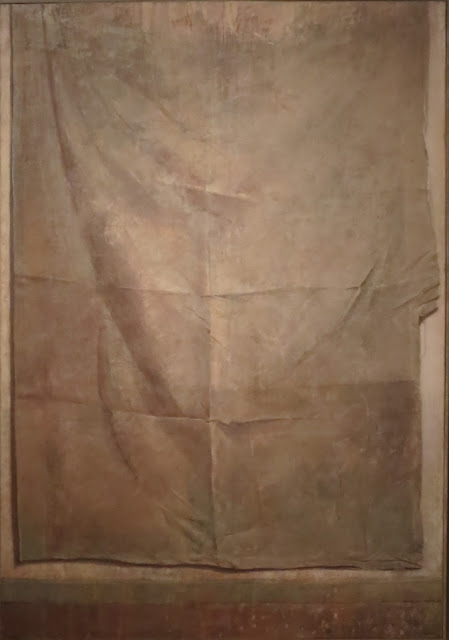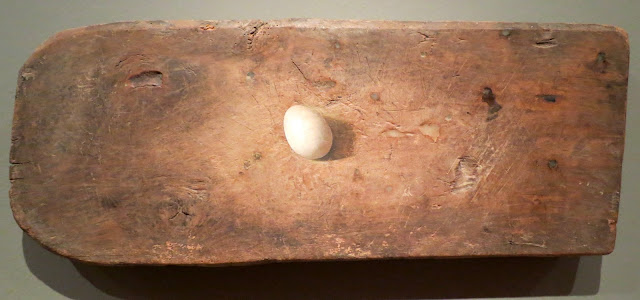Painting is a bright curtain over chaos and appearances are a glimpse of the obscure.
Christos Bokoros, Glimpses of the Obscure I - Apprenticeship in Reality, at the Benaki Museum, Pireos, Athens.
An exciting new discovery as I did not know anything about this artist. I've however had a poster of 'Face of a Woman' on a wall for years, and always assumed that it was the image of a faiyum. The shock of discovery was strong when I got to the end of this first room of the exhibition and saw the face of the woman looking back at me. Now I know.
This post is of the exhibits in the first room of this exhibition, the second will follow.
I have included the words of the artist about his work faithfully, as they were given to us by the museum, without changing anything. I understand that as well as being such an accomplished and visionary painter he is also extremely knowledgeable about art history and very eloquent. He has been giving guided tours of the Tsarouchis exhibition (which is also currently running at the Benaki) which run to two and a half hours and yet everyone stays the course.
Thomas, 2016

Stamos, 2016
Pippina, 1983
I started painting when I was a small boy. I gave it up in my teens, wanting to change the world. My efforts weren't fruitful. When I completed Law School I started painting again, with care, in the 'good' room of my family home. I still have a portrait of my sister Pippina from that time. It must have been in 1983, just before I got into the School of Fine Arts. She was sitting with her hand leaning on the white almond-shaped marble of the table, dressed in black and white, a hint of a warm earthy tone on the flesh and some cool grey in the background.
At the School of Fine Arts, 1989
Back then I only used Polygnotus' four colours, the ones I read about in the texts of Yannis Tsarouchis and also learnt about in the company of the hagiographers of the city. That blurriness soothed me; it was like dust, like time's traces....
The only things I kept from my apprenticeship at the School are two pieces I painted while I watched the easels of my fellow students in the grey hall while I sat above, in a corner of the attic, and one of the bright view of the bitter-orange trees outside the window.
Orange Tree, 2000
She Who Sleeps 1, 1986
She Who Sleeps, 1986
Feeling awkward in the presence of the School's models I'd return home and paint everything around me: girls, rooms, objects of everyday use, the kitchen illuminated at night, Lena lying asleep in bed, Maritsa coming out of the bathroom in a pink bathrobe or lying scantily clad on the sofa in her petticoat, the wall, a linen cloth that hung upon it, a trace of milk on the mosaic, the bedroom, nudes, myself...
Kitchen, Kallidromiou Street, 1990
Couple in the Bath, 1987
He Who Sleeps, 1989
Reclining Couple, 1989
Red Thread on Wall, 1989

Bed IV, 2016
Glass and matches, 1988
One day when I was living in Kallidromiou Street I was patiently cleaning an old piece of wood - from an oak chest - which I'd found in the rubbish. It was whitewashed, rubbed smooth by repetitive use. I was always fascinated by old, used wood . I placed a glass I'd just drunk water from on it and suddenly saw it shinning in the sun that was coming through the window. I started painting what I saw on the wood: the dust and light, the obvious. I forgot about painters and devoted myself to the glass on the wood. For many days I faced difficulty. Then, instead of adding colours, I'd remove colours. I worked with my fingertips. The bare minimum. Eventually the traces of my effort seemed to have become assimilated on the living surface of the wood, along with the signs of its initial treatment and its subsequent uses'
Towel and soap, 2000
Then, on another piece of wood I painted a folded towel and a bar of soap. A fish. Then an animal bone. And more. Later, when I was exhibiting my projects from the School in 'Ora' Gallery, I wrote: 'For years I've painted in order to discover 'the way', but I am convinced more and more, that there is no other way than to love and see. After this, you will do whatever you are meant to do, and whatever is meant to become apparent will become apparent. Besides, when it comes to doubt, even if you do not carry it with you, it will follow you of its own accord'.

Paintbrush, 1989
Folded Sheet, 2000
Egg, 1991
Theme and technical prowess were not my concern. There was something else, something more significant, I was missing. I painted an egg on a wooden chopping board. A closed white shape. Hardly anything special. If painting was of any value then this value ought to be evident in the representation of a single egg. No colourful, elaborate shapes. Is the rendering of representational skill on the time-worn surface of the wood alone sufficient evidence of the value of art, I wonder? The next exhibition consisted solely of painted eggs, humble offerings to the arrogance of their creator.
Two Eggs, 2000
Wooden Box with Eggs, 1992
Then I painted chests, boxes, to guard something secret: I wasn't sure what. I drew rectangles that ignored the rules of perspective and reverse perspective.

Wooden Box, 1991
Woman's Face, 1987
I hadn't seen many paintings in Agrinio, the place where I grew up. At the time, the only real, compelling paintings were the frescoes of the ancient temples and the images my father would show me on our tours around the local monuments. Later on in life, when I was able to view the grand paintings I had only known from mythical narratives and reproductions in books, I was thrilled above all by the legends surrounding them and by their technical excellence, though I did feel a sense of estrangement from them. As if I couldn't fit into them somehow. I was obviously meant to learn about them, to pay tribute to them for their significance - how else could I claim to be educated - but I didn't recognise anything of mine there. I felt rather small in their presence. I cursed my inadequate education, my humble origins, my provincialism; I didn't consider myself capable of even being associated with them, let alone achieving something note-worthy in art.
When at some point I came across the Greek mummy portraits of Egypt, I was dazed. They were not exactly like the paintings I knew - all of them were staring at me as if they were pleading with me for something, their gazes upon me, each one individually and all of them together, exuding an irrationally excessive power of depiction. My mind veered off the beaten track and I started to perceive art differently - representation as the presentation of a stance of some other substance. Painting yielded the gaze of eternity onto the facades of death.
And those depicted were not all high and mighty, rulers, kings, beauties, heroes or influential people of this world. They were ordinary people, just like my kin. I surrendered to the familiarity of it and recognised something akin to the forms of my people being honoured in art; something akin to the forms I always had at the back of my mind. I became aware of the meaning of the memorial as a subversion of the tomb.
The bittersweet sense of the living that were present in a presentation of the unrepresentable, in the unfamiliarity of death. I pondered the fact that it must have those kinds of human scenes that were in Theotokopoulos' (El Greco) mind before he was able to so gloriously immortalise the burial of Count Orgaz. Our memory as a memorial in the presence of death. The descent to Hades as an image of resurrection. A different kind of perception, one that is not like that of contemporaries who hide and wear the disguise of make-up and elaboration, colourful hair ad inopportune smiles, tasteless hip antics. Exaltation is what we owe life, not extension. A rising to the light, through darkness, because only through darkness does the light shine and make our hearts rejoice.
It is to such fundamental dark images that I owe whatever luminous meaning I have perceived in the art of my life. A bright curtain over chaos, that's what painting is'.

























No comments:
Post a Comment